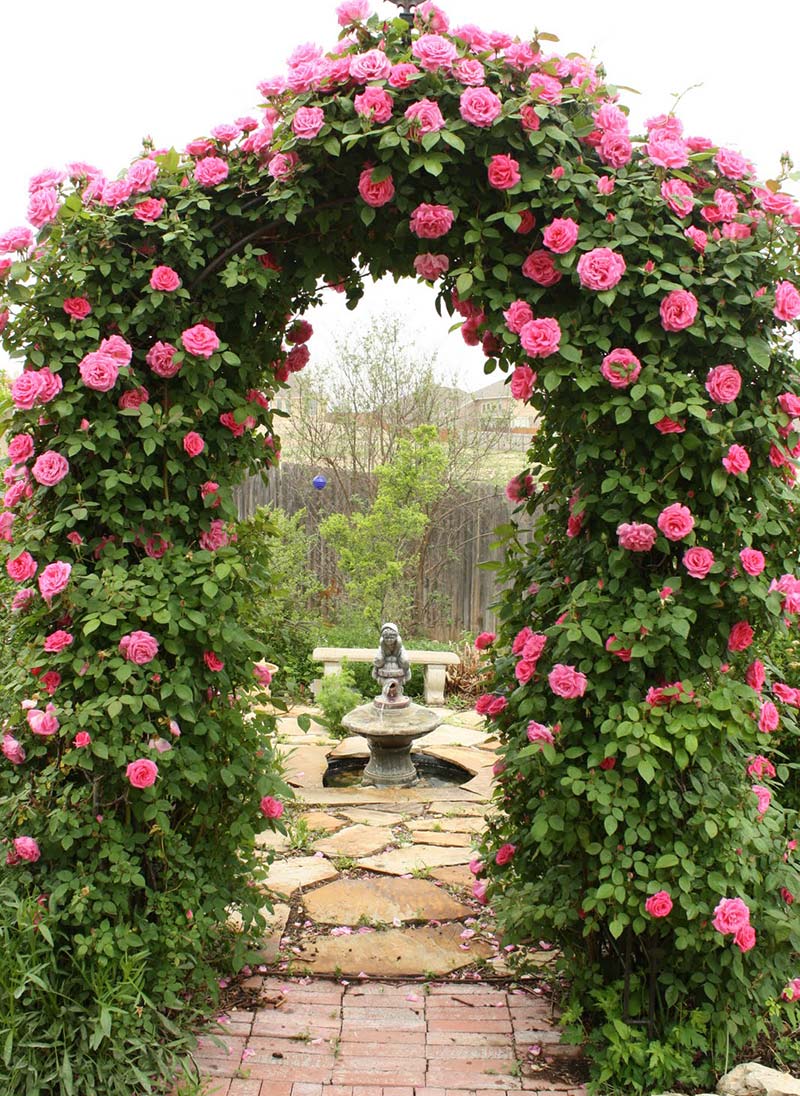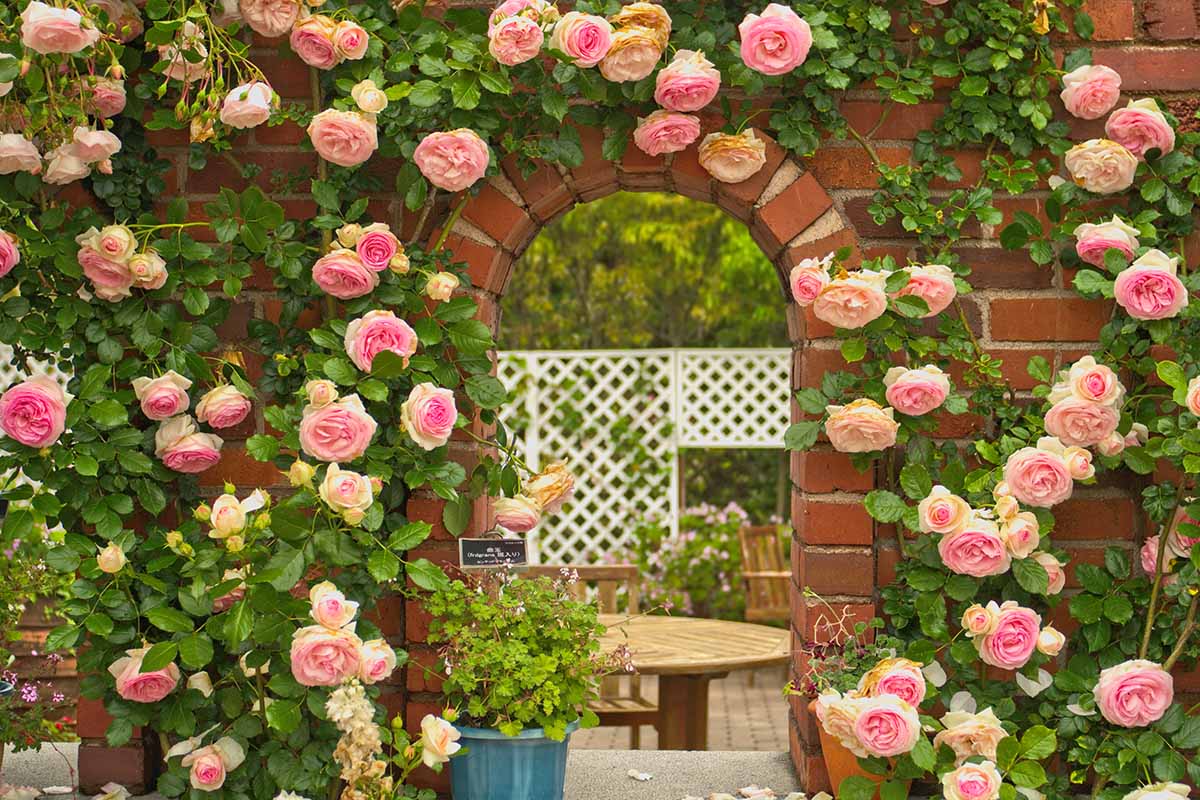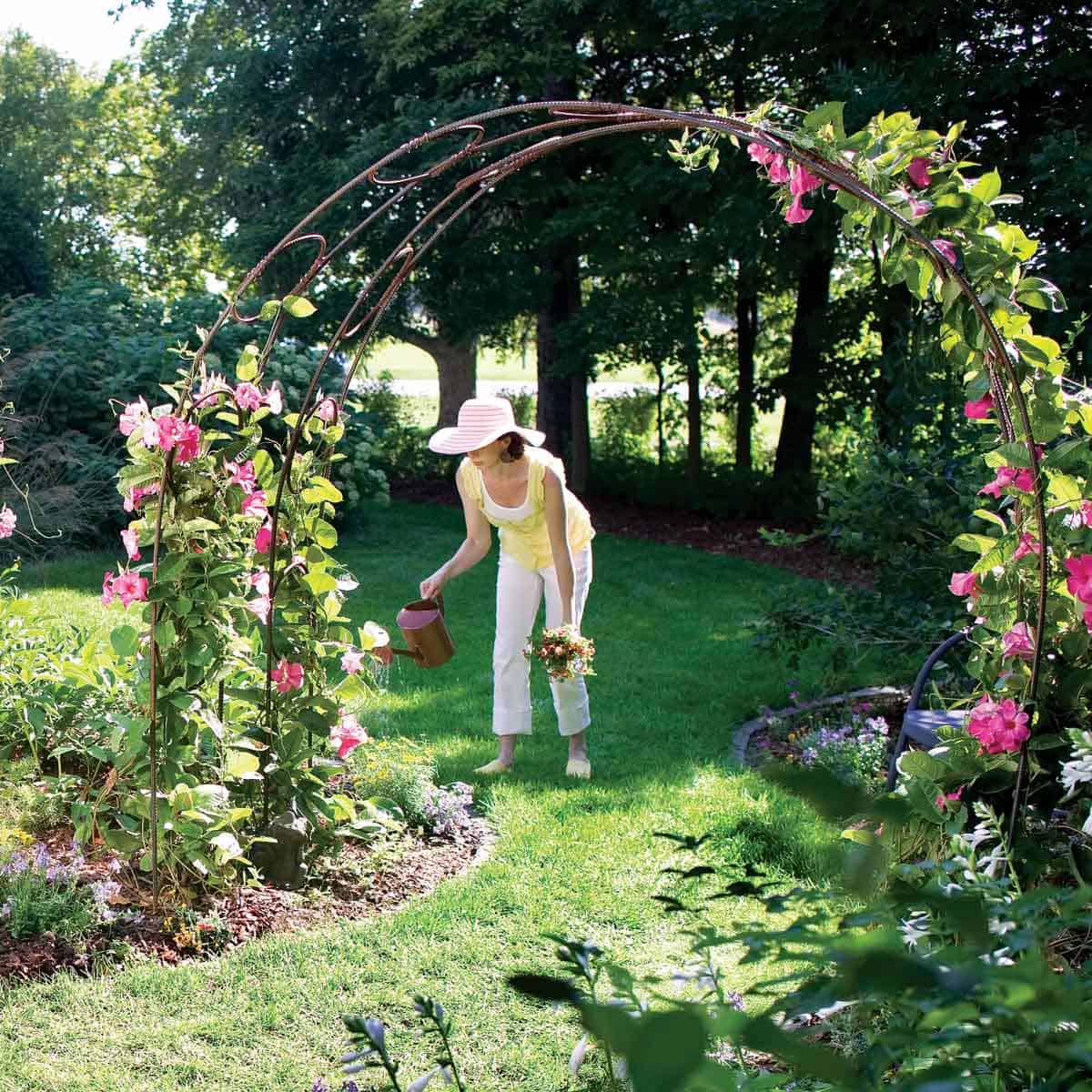Choosing the Right Rose Variety for Your Arch
Selecting the right rose variety is crucial when growing roses over an arch. Not all rose varieties are suitable for this purpose, and choosing the wrong one can lead to disappointing results. When selecting a rose variety, consider factors such as climbing ability, flower size, and disease resistance.
Climbing roses are the best choice for growing over an arch, as they have the ability to grow upwards and outwards, covering the arch with blooms. Look for rose varieties that are specifically labeled as “climbing” or “rambling,” such as ‘Cecile Brunner’ or ‘New Dawn’. These varieties have long, flexible canes that can be trained to grow over the arch.
Flower size is also an important consideration when selecting a rose variety for your arch. Larger flowers can create a more dramatic display, but may require more support to prevent them from drooping. Smaller flowers, on the other hand, can create a more delicate, lacy effect.
Disease resistance is another important factor to consider when selecting a rose variety. Look for varieties that are resistant to common rose diseases, such as black spot and powdery mildew. This will help to ensure that your rose arch remains healthy and thriving over time.
Some popular rose varieties for growing over an arch include ‘Cecile Brunner’, ‘New Dawn’, and ‘Lady Banksia’. These varieties are all known for their climbing ability, disease resistance, and beautiful blooms.
Ultimately, the right rose variety for your arch will depend on your personal preferences and the specific conditions of your garden. By considering factors such as climbing ability, flower size, and disease resistance, you can choose a rose variety that will thrive in your garden and create a beautiful display over your arch.
Preparing the Perfect Arch for Your Roses
When it comes to growing roses over an arch, the arch itself is just as important as the roses. A well-designed and sturdy arch can provide the perfect support for your roses, while a poorly designed arch can lead to disappointment and frustration. In this section, we’ll discuss the key considerations for preparing the perfect arch for your roses.
The first consideration when preparing an arch for your roses is the material. You’ll want to choose a material that is sturdy and durable, yet also aesthetically pleasing. Popular options include wood, metal, and stone. Wood is a popular choice for rose arches, as it can be easily shaped and molded to create a beautiful and intricate design. Metal arches are also a good option, as they can be made to be very sturdy and can support a large amount of weight. Stone arches are a more permanent option, and can add a touch of elegance to your garden.
Once you’ve chosen the material for your arch, you’ll need to consider the size. The size of the arch will depend on the size of your roses and the space available in your garden. A larger arch can provide more support for your roses, but may also be more expensive and take up more space. A smaller arch can be a good option for smaller gardens or for roses that don’t require as much support.
Placement is also an important consideration when preparing an arch for your roses. You’ll want to choose a location that receives plenty of sunlight and has good air circulation. This will help to promote healthy growth and prevent disease. You’ll also want to consider the surrounding plants and features in your garden, and choose a location that complements them.
Finally, you’ll want to ensure that your arch is sturdy and secure. This can be achieved by anchoring the arch to the ground or to a nearby wall. You’ll also want to make sure that the arch is level and plumb, to prevent it from leaning or toppling over.
By considering these key factors, you can prepare the perfect arch for your roses. A well-designed and sturdy arch can provide the perfect support for your roses, and help to create a beautiful and thriving garden feature.
How to Train Your Roses to Grow Over the Arch
Training your roses to grow over an arch can be a bit of a challenge, but with the right techniques and a little patience, you can achieve a beautiful and thriving rose arch. The key to successful training is to provide the right support and guidance for the rose canes as they grow.
The first step in training your roses is to prune them regularly. Pruning will help to encourage the rose canes to grow upwards and outwards, rather than inwards and downwards. It will also help to promote healthy growth and prevent disease. When pruning, make sure to remove any dead or damaged wood, and cut back the canes to about 12-18 inches from the ground.
Once you have pruned your roses, you can begin to train them to grow over the arch. To do this, you will need to tie the canes to the arch using a soft material such as twine or wire. Start by tying the canes to the arch at the base, and then work your way up, gently twisting the canes around the arch as you go. Make sure to leave enough space between the canes for good air circulation and sunlight penetration.
As the rose canes grow, you will need to continue to train them to grow over the arch. This can be done by gently twisting the canes around the arch, and by removing any weak or spindly growth. You can also use clips or ties to attach the canes to the arch, especially if they are particularly long or heavy.
It’s also important to provide support for the rose canes as they grow. You can do this by installing a trellis or other support system near the arch. This will help to keep the canes upright and prevent them from becoming too heavy for the arch.
By following these steps and providing the right support and guidance, you can train your roses to grow over an arch and create a beautiful and thriving garden feature. Remember to be patient, as training roses can take time and effort. But with the right techniques and a little care, you can achieve a stunning rose arch that will be the envy of all your friends and neighbors.
Providing Ongoing Care for Your Rose Arch
Once your rose arch is established, it’s essential to provide ongoing care to keep it healthy and thriving. Regular maintenance is crucial to ensure the longevity of your rose arch and to prevent common problems that can arise when growing roses over an arch.
Watering is one of the most critical aspects of caring for your rose arch. Roses need consistent moisture, especially when they’re growing over an arch. Make sure to water your roses regularly, but avoid overwatering, which can lead to root rot and other problems. Aim to provide about 1-2 inches of water per week, either through rainfall or irrigation.
Fertilizing is also essential for promoting healthy growth and blooming. Use a balanced fertilizer that’s specifically formulated for roses, and follow the instructions on the label for application rates and timing. It’s also a good idea to add a layer of compost or well-rotted manure around the base of the roses to provide additional nutrients.
Pruning is another critical aspect of caring for your rose arch. Prune your roses regularly to promote healthy growth, encourage blooming, and remove any dead or diseased wood. Prune in late winter or early spring, removing any dead or damaged canes and cutting back the remaining canes to about 12-18 inches from the ground.
In addition to these regular maintenance tasks, it’s also essential to keep an eye out for common problems that can arise when growing roses over an arch. Keep an eye out for pests like aphids, whiteflies, and spider mites, and treat promptly if you notice any infestations. Regularly inspect your roses for signs of disease like black spot, powdery mildew, and rust, and treat promptly if you notice any problems.
By providing ongoing care and maintenance for your rose arch, you can keep it healthy and thriving for years to come. With regular watering, fertilizing, pruning, and pest and disease management, you can enjoy a stunning and fragrant rose arch that’s the envy of all your friends and neighbors.
Common Challenges and Solutions for Growing Roses Over an Arch
Growing roses over an arch can be a rewarding experience, but it’s not without its challenges. From pests and diseases to weather damage and structural issues, there are several common problems that can arise when growing roses over an arch. In this section, we’ll discuss some of the most common challenges and provide solutions and advice on how to overcome them.
One of the most common challenges when growing roses over an arch is pests. Aphids, whiteflies, and spider mites are all common pests that can infest roses, and can be particularly problematic when growing roses over an arch. To control pests, use a combination of cultural and chemical controls. Keep the area around the arch free of debris and weeds, and use insecticidal soap or neem oil to control infestations.
Diseases are another common challenge when growing roses over an arch. Black spot, powdery mildew, and rust are all common diseases that can affect roses, and can be particularly problematic when growing roses over an arch. To control diseases, use a combination of cultural and chemical controls. Keep the area around the arch free of debris and weeds, and use fungicides to control infestations.
Weather damage is another common challenge when growing roses over an arch. High winds, heavy rainfall, and extreme temperatures can all cause damage to the arch and the roses. To prevent weather damage, use a sturdy arch that is securely anchored to the ground, and provide support for the roses using ties or clips.
Structural issues are another common challenge when growing roses over an arch. The arch may become damaged or weakened over time, particularly if it is not properly maintained. To prevent structural issues, inspect the arch regularly and make repairs as needed. Use a sturdy material for the arch, such as wood or metal, and ensure that it is securely anchored to the ground.
By being aware of these common challenges and taking steps to prevent them, you can keep your rose arch looking its best and ensure that it remains a beautiful and thriving feature in your garden.
Adding a Finishing Touch: Decorating Your Rose Arch
Once your rose arch is established and thriving, you can add a finishing touch by decorating it with other plants, ornaments, or decorative features. This can enhance the overall appearance of the arch and create a beautiful focal point in your garden.
One way to decorate your rose arch is to add other plants that complement the roses. For example, you can plant climbing plants like clematis or honeysuckle around the base of the arch, or add some flowering shrubs like lavender or rosemary nearby. This can create a beautiful and fragrant display that attracts pollinators and adds visual interest to the garden.
Another way to decorate your rose arch is to add ornaments or decorative features. For example, you can hang wind chimes or bird feeders from the arch, or add some decorative planters or pots around the base. This can add a touch of personality to the garden and create a unique and interesting display.
You can also use lighting to decorate your rose arch. For example, you can string fairy lights or lanterns around the arch, or add some solar-powered lights to highlight the roses and other plants. This can create a beautiful and romantic ambiance in the garden, especially in the evening or at night.
Finally, you can use decorative features like trellises or arbors to add a finishing touch to your rose arch. For example, you can place a trellis or arbor nearby to provide additional support for the roses, or add some decorative screens or panels to create a sense of enclosure and intimacy in the garden.
By decorating your rose arch with other plants, ornaments, or decorative features, you can create a beautiful and unique display that adds visual interest and personality to your garden. Whether you prefer a simple and elegant look or a more elaborate and ornate display, there are many ways to decorate your rose arch and make it a stunning focal point in your garden.
Maintenance and Upkeep: Ensuring Your Rose Arch Remains Beautiful for Years to Come
Maintenance and upkeep are crucial to ensuring that your rose arch remains beautiful and thriving for years to come. Regular inspections and repairs can help prevent damage and ensure that the arch continues to provide support for the roses.
One of the most important things to check for when inspecting your rose arch is damage to the structure. Look for signs of wear and tear, such as cracks or breaks in the wood or metal, and make repairs as needed. You can use a variety of materials to repair your rose arch, including wood glue, nails, or screws.
In addition to inspecting the structure of your rose arch, you should also check the roses themselves. Look for signs of disease or pests, such as black spot or aphids, and take action to control them. You can use a variety of methods to control pests and diseases, including pruning, spraying, or using organic controls.
Another important aspect of maintaining your rose arch is pruning. Pruning can help control the size and shape of the roses, as well as promote healthy growth and blooming. You can prune your roses at any time of the year, but the best time is usually in late winter or early spring.
Finally, you should also consider adding a protective coating to your rose arch to protect it from the elements. You can use a variety of materials, including varnish, paint, or sealant, to protect the wood or metal from rot, rust, or corrosion.
By following these tips and performing regular maintenance and upkeep, you can ensure that your rose arch remains beautiful and thriving for years to come. With a little care and attention, your rose arch can become a stunning focal point in your garden, providing a beautiful display of roses and a sense of enclosure and intimacy.
Maintenance and Upkeep: Ensuring Your Rose Arch Remains Beautiful for Years to Come
To keep your rose arch looking its best and ensure it remains a stunning focal point in your garden for years to come, regular maintenance and upkeep are essential. Inspecting the arch and roses regularly will help identify any potential issues before they become major problems. Check the arch for signs of wear and tear, such as loose screws or rotten wood, and make repairs as needed. Also, inspect the roses for signs of pests or diseases, and take action promptly if you notice any issues.
Pruning is a critical aspect of maintaining a healthy and thriving rose arch. Prune your roses regularly to promote new growth, encourage blooming, and maintain the desired shape. Remove any dead, diseased, or damaged wood, and cut back canes to encourage new growth. Prune your roses in late winter or early spring, before new growth begins, to minimize the risk of disease and promote healthy growth.
In addition to pruning, regular watering and fertilization are crucial for maintaining a healthy rose arch. Water your roses deeply once or twice a week, depending on weather conditions, and fertilize them regularly with a balanced fertilizer. Mulching around the base of the roses will help retain moisture, suppress weeds, and regulate soil temperature.
Another important aspect of maintaining a rose arch is providing support for the canes. As the roses grow and produce more blooms, the canes can become heavy and may need additional support to prevent them from breaking or sagging. Use soft ties or twine to tie the canes to the arch, taking care not to damage the stems or restrict growth.
Finally, consider protecting your rose arch from extreme weather conditions, such as strong winds or intense sunlight. Providing shade or wind protection can help prevent damage to the roses and extend their blooming season. By following these maintenance and upkeep tips, you can enjoy your beautiful rose arch for years to come and create a stunning focal point in your garden.









